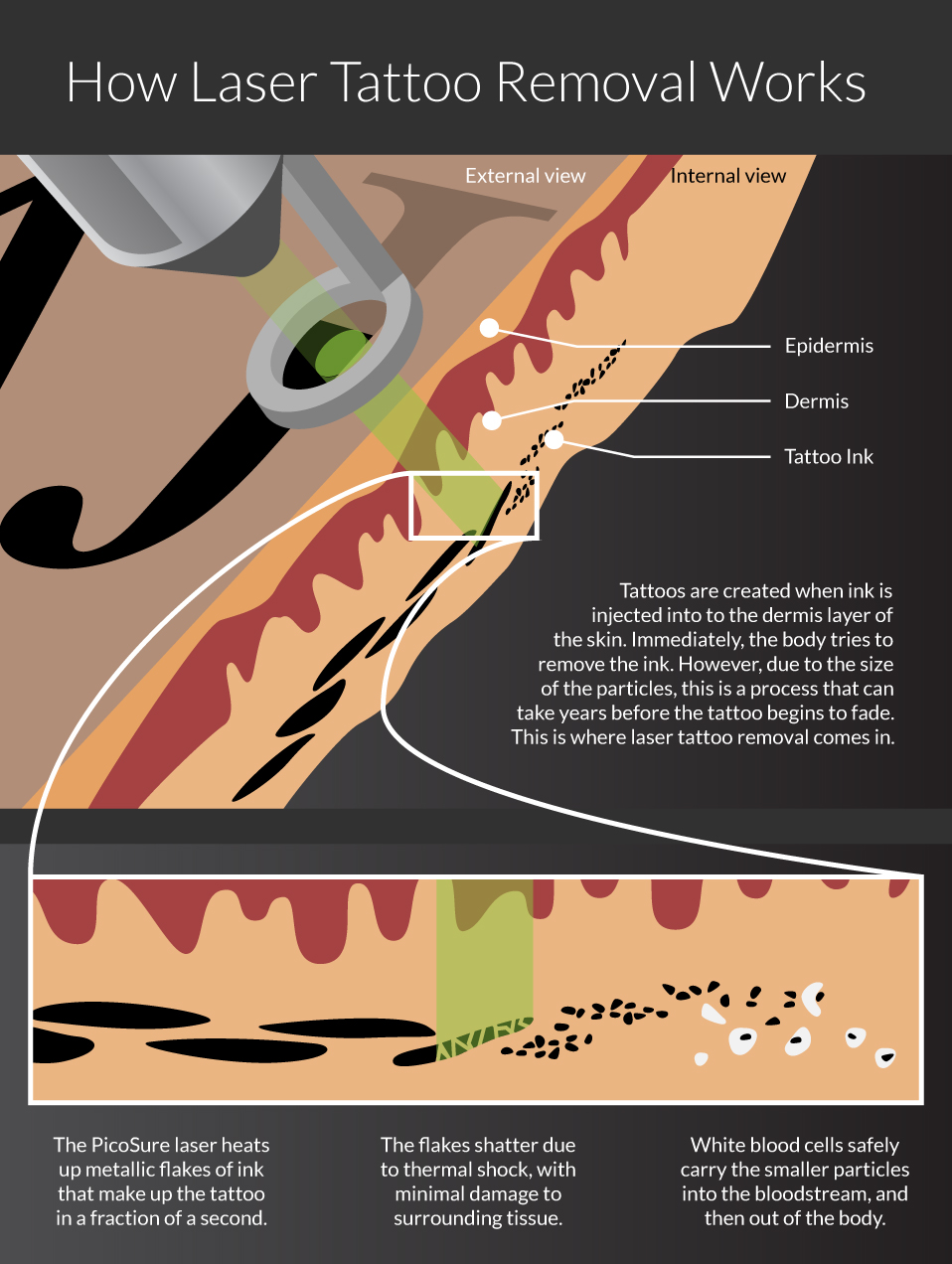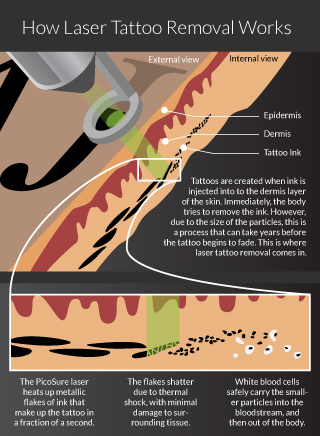Tattoo Removal
PicoSure® at Our Tucson and Oro Valley Practice Reduces the Appearance of Unwanted Ink

Pigmented lesion, scar, and tattoo removal, as well as overall skin rejuvenation.
PicoSure® from Cynosure is one of the newest picosecond lasers that use an ultra-short picosecond pulse duration to break up pigment in the skin, making it particularly well suited for tattoo removal at our Tucson and Oro Valley, AZ, practice. If you want the newest technology in tattoo removal, the picosecond laser is the best option for anyone who wants to get rid of tattoo ink for any reason. Whether it is to project a new image, to remove a tattoo you now regret, or to lighten an image to make way for a smaller, less dramatic cover-up, this is the laser for you.
Treatment times vary since every patient, tattoo, and the inks themselves are all different. After exploring the various tattoo removal options available, the Ironwood Dermatology team has determined that PicoSure® offers superior results.
Call 520.618.1630 or contact us to learn more about pigmented lesion and tattoo removal in Tucson and Oro Valley, AZ, by licensed aesthetic providers at Ironwood Dermatology.
book a consultation

The Picosecond Difference in Tattoo Removal
Nanosecond or "Q-Switch" lasers have long been considered the standard of care for tattoo removal. Such lasers relied mainly on the photothermal action (or the combination of light and heat) to target and disrupt pigment to fade away tattoos and other discolorations in the skin.
Over several treatment sessions, nanosecond pulse lasers would break down the "rocks" of ink in the skin into smaller "pebbles"—but there were limits to the extent the ink could be broken down, so significantly clear tattoo removal was often not possible. Also, the heat energy generated contributed to less-than-comfortable tattoo removal sessions.
As is the nature of technology, nanosecond pulse lasers have given way to picosecond pulse ones. A "picosecond" is a smaller fraction of time than a "nanosecond," which means each light pulse travels to a target area at a much faster rate.

Ironwood Dermatology is a proud recipient of Tucson's 2022 Reader's Choice awards for Best Dermatologist/Dermatology Practice, and Best Laser Tattoo Removal!
The PicoSure® laser's ultra-short pulse duration generates a patented photomechanical effect known as PressureWave™, which results in better clearance of tattoo ink: The "rocks" are broken down into "sand"—much smaller particles the body can more easily process. The laser's precision minimizes the resultant heat energy or injury to surrounding skin.
The increased speed of PicoSure® also reduces the duration of each tattoo removal treatment session, as well as the total number of visits required to achieve significant tattoo removal. It can also be used on the shadows of tattoos only partially cleared off by older nanosecond lasers, as well as on stubborn ink colors such as blues and greens.
How to Prepare for Laser Tattoo Removal
Preparing for tattoo removal is crucial to ensuring a smooth treatment. The tattoo must be at least six weeks old before you can get it removed, and most tattoo removals require more than one treatment to be eliminated, especially for colored tattoos, which need more time.
Consultation
A tattoo removal consultation is needed to establish the estimated number of required treatments. Several factors will determine the number of visits you'll need. These factors include the colors of the tattoo, tattoo age, your skin color, ink vividness, and the tattoo location on the body.
What to Expect During Skin Treatments
Discomfort can be managed
As far as pain is concerned, be aware that patients typically say that the treatment causes discomfort. It is similar to getting a tattoo, but tattoo removal is a much faster process, so any discomfort experienced is short-lived. A numbing cream can be administered to ease any pain.
Results are not immediate
Until your consultation, there is no definite answer as to how long the treatment will take. Typically, tattoo removal sessions are spaced out anywhere from six to eight weeks apart. After several visits, you should begin to notice the tattoo gradually fading away.
The tattoo will have a white appearance
After treatment, your tattoo will look white. This effect is known as frosting, and it typically lasts about 10 to 15 minutes before disappearing. The tattoo ink may seem more vibrant once the frosting goes away, but on a microscopic level, the ink has been broken up into small particles. The body does the rest of the work to clear the fragments.
What to Avoid After a Treatment
Avoid exercise, lotion, and make-up
It is important not to apply products such as make-up or cream on the treated area because they can increase the risk of blistering. It would be best if you avoided performing any form of exercise right after treatment, as this can also cause blistering or bleeding. However, it is safe to resume activity after 24 hours have passed. Rarely, people may still experience some blistering after a tattoo removal treatment due to their sensitive skin. Avoid popping or picking any blister to prevent the possibility of infection.
Avoid excessive sun and water exposure
Following a tattoo removal treatment, you should refrain from staying in the sun for long periods, as well as heavy water activities including pools, lakes, ocean, and hot tubs. If you had a color tattoo, you should completely avoid sun exposure on the treated area. After about five to seven days (or until the area has healed), you may resume these activities. It is always recommended to wear sunscreen over a tattoo—and all exposed skin—when outdoors.
Other Uses for the PicoSure® Device
Tattoo removal is not the only benefit the PicoSure® laser offers. Because it can break up pigment besides tattoo ink, and it offers dual wavelength options, our dermatologists can use the laser for skin rejuvenation and facial resurfacing. Our skin treatments help minimize the look of minor skin imperfections for both women and men in Tucson. The results are comparable to other non-ablative or ablative lasers, but without the added prep time, discomfort, or recovery.
All of these features make PicoSure® an effective method to treat fine lines and wrinkles, hyperpigmentation as a result of melasma, cumulative sun exposure, and age. It is also well suited for revision of scars from acne or other causes. Overall pore size, texture, and tone of treated skin can also show improvements.
Call Ironwood Dermatology at 520.618.1630 or contact us to determine whether you are a good candidate for PicoSure® tattoo removal in Tucson and Oro Valley, AZ.
book a consultation











